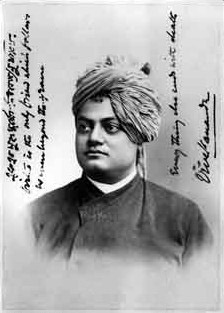Buddhism, the Fulfilment of Hinduism
 Swami Vivekananda in Chicago in 1893 | |
| Date | 26 September 1893 |
|---|---|
| Location | Chicago, United States |
| Website | www |
"Buddhism, the Fulfilment of Hinduism" is a lecture delivered by Indian Hindu monk and expounder Swami Vivekananda on 26 September 1893 at the Parliament of the World's Religions in Chicago. In this lecture, he expressed his opinion that "Buddhism was the fulfilment of Hinduism."[1]
Background
In 1893, Swami Vivekananda went to the United States and joined the Parliament of the World's Religions as a delegate of Hinduism and India, which ran from 11 to 27 September in that year in Chicago. This event also marked the first world conference of the representatives of Eastern and Western religions. After his introductory speech to the Parliament of religions on 11 September 1893, which was of a general nature stating no religion was superior or inferior to the other, his subsequent lectures were on 15th, 19, 20 and 26 September were on specific issues of religion.[2]
Lecture
This lecture was delivered on 26 September 1893.
Swamiji elaborated on the reasons for the near total elimination of the Buddhist religion (
Swamiji also stated that Buddhism should not be confused with
Significance
According to Rabindra Kumar Dasgupta, the author of Swami Vivekananda on Indian philosophy and literature, it was his "historic address on Buddhism".[6] A summary of the lecture was published The Indian Mirror on 29 June 1895, which emphasised the concluding words of the lecture—[7]
We cannot live without you, nor you without us. Then believe that separation has shown to us, that you cannot stand without the brain and the philosophy of the Brahman [sic], nor we without your heart. This separation between the Buddhist and the Brahman [Brahmin] is the cause of the downfall of India. That is why India has been the slave of conquerors for the past 1000 years. Let us then join the wonderful intellect of the Brahman [Brahmin] with the heart, the noble soul, the wonderful humanising power of the Great Master.
The Srilankan Buddhist Dharmapala equally spoke at this gathering and stressed on Buddha's word as a universal Teaching.[8]
References
- ^ a b Amore 1979, p. 74.
- ^ Ghosh 2003, p. 81.
- ^ a b c Vivekananda, p. 28.
- ^ "The 1893 World's Fair". Vivekananda Vedanta Society of Chicago. Retrieved 17 September 2013.
- ^ a b c d e King 2013, p. 97.
- ^ Dasgupta 1996, p. 102
- ^ "A summary of Buddhism, the Fulfilment of Hinduism". The Indian Mirror. 29 June 1895. Archived from the original on 13 September 2013. Retrieved 13 September 2013.
- ^ "Archived copy" (PDF). Archived from the original (PDF) on 13 April 2021. Retrieved 31 May 2018.
{{cite web}}: CS1 maint: archived copy as title (link)
Bibliography
- Amore, Roy C. (1979). Developments in Buddhist Thought: Canadian Contributions to Buddhist Studies. Wilfrid Laurier Univ. Press. ISBN 978-0-919812-11-6.
- Dasgupta, Rabindra Kumar (1996). Swami Vivekananda on Indian philosophy and literature. Ramakrishna Mission Institute of Culture. ISBN 978-81-85843-81-0.
- Ghosh, Gautam (2003). The Prophet of Modern India: A Biography of Swami Vivekananda. Rupa & Company. ISBN 978-81-291-0149-5.
- King, Richard (3 April 2013). Orientalism and Religion: Post-Colonial Theory, India and "The Mystic East". Routledge. ISBN 978-1-134-63234-3.
- Vivekananda, Swami. Swami Vivekananda at the Parliament of Religions. Indic Publication. ISBN 978-1-301-19120-8.

